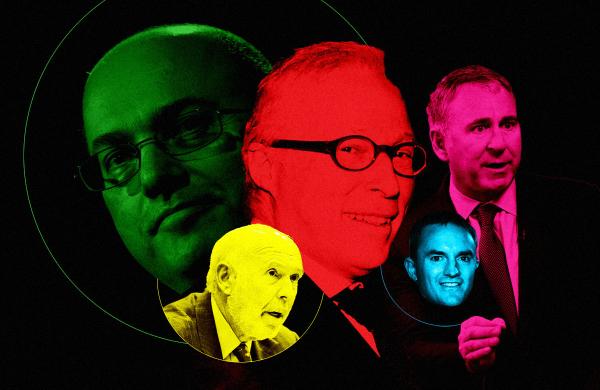It is better to give back than to receive.
That, evidently, is what some of the world's most successful hedge fund managers think. After a year in which industry assets soared -- thanks to healthy inflows and snappy market gains -- a number of the most notable names in the business are returning scads of capital to their investors. Prominent among these fund managers are members of the 2004 Hedge Fund 100, our third annual ranking of the biggest single-manager hedge fund complexes by assets in the world
For the second year in a row, the list is topped by Bruce Kovner's Caxton Associates, with $11.5 billion as of December 31, 2003, followed closely by GLG Partners of London, with $11 billion and Citigroup Alternative Investments, at $9.9 billion. Rounding out the top five are Farallon Capital Management of San Francisco, at $9.856 billion, and Chicago's Citadel Investment Group, at $9.5 billion.
Altogether, the assets of the 100 largest managers rose by $99 billion, or almost 30 percent, to $439 billion in the year through December 2003. That represents 54 percent of the $817 billion in assets in the total hedge fund universe, as estimated by Hedge Fund Research, a Chicago-based database company. In 2002 the Hedge Fund 100 accounted for 49 percent of total industry assets.
The asset totals and rankings are a snapshot of one moment in time, of course, and the picture can change dramatically. Among the leading money returners are Caxton, Louis Bacon's Moore Capital Management (No. 19 in our ranking), Richard Perry's Perry Capital (No. 20), James Simons' Renaissance Technologies Corp. of East Setauket, New York (No. 30), Matthew Tewksbury's Hamilton, Bermudabased Tewksbury Capital Management Co. (No. 59) and David Tepper's Appaloosa Management of Chatham, New Jersey (No. 68).
"We don't want to get too big," says Tepper, who was up nearly 150 percent net of fees last year. He gave back $500 million in mid-2003 and an additional $800 million at year-end. A distressed-investment specialist, Tepper was concerned that with assets so swollen, Appaloosa might not be able to execute its strategy effectively. "The day will come," he says, "when we give back money again."
In July, Renaissance returned all of the first-half gains of its only fund, Medallion; in January it handed back all of its second-half gains as well as some capital of nonemployees. It plans to return all first-half 2004 profits generated. Moore, which ran $6.1 billion as of year-end 2003, had its fifth straight year of mandatory net redemptions in its macro program, and in March the firm distributed $450 million -- the most recent year's profits -- from the Moore Global Fixed Income Fund. Caxton returned 20 percent of its investors' money in Caxton Global Investments at year-end, reducing the firm's single-manager hedge fund capital from $11.5 billion to $9.5 billion. "We wanted a smaller base to maintain our historical rate of return," says a spokesman. In 2003, Caxton Global Investments had its worst year in a decade, earning a return of only 8.1 percent.
Tewksbury gave back between $400 million and $500 million last May; Tewksbury Investment Fund returned 10.73 percent in 2003, its worst performance in nearly a decade when the record of its predecessor fund, Trout Trading Management, is included. And Perry Capital returned about $1 billion last May after closing down its two European funds.
Givebacks aside, institutional asset inflows continue to fill hedge fund coffers. "There continues to be a large appetite for hedge fund diversification," says Lawrence Simon, president and CEO of fund-of-hedge-funds manager Ivy Asset Management Corp., which runs more than $10 billion. "People announce today they want to 'dip their toe in,' and they start with 3 percent to 5 percent or even higher."
Our listings provide each manager's total hedge fund assets (before leverage) and, where possible, assets and one-year returns (net of fees) for up to five funds. All data are as of year-end 2003 unless otherwise noted. Data were gathered from questionnaires completed by hedge fund managers and supplemented by staff research. We have excluded funds of funds, funds that are subadvised by a third party and assets managed in collateralized bond and debt obligations. Also excluded: private equity funds and vehicles that resemble private equity funds. Commodity trading advisers are ranked based on their actual rather than nominal assets.
In some cases, managers have rolled multiple funds run in a single style into one entity and reported composite figures for assets and returns. If we missed your firm this year, please contact us at HF100@iimagazine.com so we can consider you for the 2005 list.
This ranking was compiled under the direction of Assistant Managing Editor for Research Lewis Knox and Senior Editor Jane B. Kenney, with assistance from Contributing Editor Stephen Taub, Senior Writers Loch Adamson and Justin Schack, Staff Writer Rich Blake and Researchers Russell Bradley-Cook and Anastacio Teodoro IV.
| Alpha's Hedge Fund Top 5 | ||
| Rank | Firm | Total capital ($ millions) |
| 1 | Caxton Associates | $11,500 |
| 2 | GLG Partners | 11,017 |
| 3 | Citigroup Alternative Investments | 9,900 |
| 4 | Farallon Capital Mgmt | 9,856 |
| 5 | Citadel Investment Group | 9,500 |





